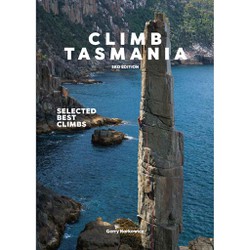Seasonality
Summary
Quartzite trad climbing up to 50m high.
Description
The crags offer a range of climbs in idyllic settings beside the sea. The main crag above Cave Bay has superb quality rock particularly at the north (L) end, hard and glassy, and steep although the rest of the crag is a bit more broken and a little loose in places. Most of the climbs can be climbed in one (at times, long, rope stretching) 50m pitch although many were climbed originally in two pitches or more.
Decent from the cliff can be made with 2 or 3 rappels on fixed slings to the right of Zoro. There is a slung boulder at the very top of the ridge and end of pitch 4 of Zoro. The next point is 5m right of the top of the third pitch of Zorro. A 60m rope at full stretch should get you from here to the ground, alternatively there is a third point at the end of the second pitch of Zoro.
This area is of great spiritual significance to the Tasmanian Aboriginal people, and Aboriginal sites such as the cave and middens are fully protected by law. Please respect the historic and spiritual values they represent by leaving them as you found them. We strongly recommend that climbers avoid the routes round the North Cave area in particular. The old descent gully should also be avoided for this reason.
Access issues
This area is of great spiritual significance to the Tasmanian Aboriginal people, and Aboriginal sites such as the cave and middens are fully protected by law. Please respect the historic and spiritual values they represent by leaving them as you found them. We strongly recommend that climbers avoid the routes round the North Cave area in particular.
The old descent gully should also be avoided for this reason. Decent from the cliff can be made with 2 or 3 rappels on fixed slings to the right of Zoro. There is a slung boulder at the very top of the ridge and end of pitch 4 of Zoro. The next point is 5m right of the top of the third pitch of Zorro. A 60m rope at full stretch should get you from here to the ground, alternatively there is a third point at the end of the second pitch of Zoro.
Peregrine falcons nest on the cliffs so keep away from any nest and out of sight during the breeding season from August through to December. The most common site of nests has been near North Cave/Ramps are, so there is a standing seasonal closure of extending from Zorro wall to the ramp area (inclusive). If they do appear anywhere else, and you get persistent “hecking” calls from a falcon during the nesting period, back off.
Where to stay
Camping is not permitted in the national park.
Ethic
Crag Stewards
Rock climbers please contact the Crag Steward (sistersbeachrockycape@climbersclubtas.org.au) if you have any queries or concerns regarding social or environmental impacts of rock climbing at this crag.
Do not email regarding general travel, seasonal advice, or lost property - this is not the Steward’s role. If you have important safety information to communicate (e.g. risks due to recent and large rock falls) please also consider updates on thesarvo forum, Facebook group and/or online guidebooks as appropriate. Please copy in cct@climbersclubtas.org.au if you feel you have a high-level concern which may imminently impact the crag or climbing community.
Non-climbers, other users, land managers: please also contact cct@climbersclubtas.org.au if you have important climbing related queries at this location.
Other
• The operation and use of drones by park visitors on reserved land including national parks is not permitted
• Peregrine Falcons nest from July - December each year. It’s important that climbers don’t climb near active nests during this period. Known sites (non exhaustive) are: Sand River (Far East, The Panopticon), Bare Rock (R of the Boneyard, L of Bisso of Orange), Rocky Cape, Pubic Wall/Duck Reach, Hillwood, Gunners Quoin, Lowdina.
• Please note that Tasmania has notoriously patchy phone reception for particular service providers. Telstra is the most reliable. An emergency Personal Locator Beacon or similar is recommended kit when climbing in remote locations.
• For more information - follow the link below for some local tips + tricks on how to better reduce your impact during your next Tassie climbing holiday https://www.cragcaretasmania.org.au/learn
History
Recent research suggest these ancient rock formations are one and the same as those in the Grand Canyon, USA.
"We concluded that although it’s now on the opposite side of the planet, Tasmania must have been attached to the western United States"
Plan your Trip
Information needed
This crag does not have approach information. Could you describe the approach to this crag?
If you can help provide a better quality resource for the climbing community then please click 'edit this crag' button near the top of the page.
Selected Guidebooks more Hide
Author(s): Gerry Narkowicz
Date: 2021
ISBN: 9780646841946
Cracks, sea stacks, big walls, remote exotic locations, volcanic columns, no crowds and your choice of the predominant dolerite, some quartzite and a little sandstone to remind you of the mainland. Many a wilderness climbing experience can be had within a 2hr car trip from the main centers. By Gerry Narkowicz. This guide features 1280 routes.
Accommodations nearby more Hide
Share this
Get a detailed insight with a timeline showing
- Ticks by climbers like you
- Discussions of the community
- Updates to the index by our users
- and many more things.
Login to see the timeline!

